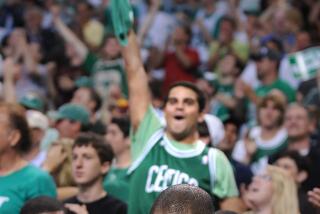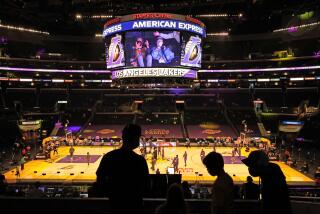The Early Birds
Two societies of Laker fans reside at Staples Center.
One occupies courtside and extends up to the luxury boxes. It tends to be movie stars and their hangers-on, corporate types and their clients, and other super-rich people who can afford the tickets. These fans fit the game into their schedules rather than organize their schedules around the game. They are notorious -- and legendary -- for arriving late.
Then there are the Laker fans who cheer in the upper reaches of the arena, where my sister was recently lucky enough to score a pair of tickets for a playoff game. Overjoyed at the chance to root for the Lakers in person, she had put on her bootleg Derek Fisher 0.04 Shot T-shirt and left her home in El Monte at 3 o’clock in the afternoon, arriving at the arena an hour before people were allowed in.
My sister was not the only early-bird fan. Hundreds rode with her up the escalators to their seats among the Lakers’ nine Los Angeles championship banners, the retired superstar numbers and Chick Hearn’s golden microphone jersey.
Below, there was barely a soul.
It was my sister’s first playoff game. In fact, it was the first for our entire family, though we have been Laker fans for more than two generations.
I go back 20 years with this team. My father goes back even further. Gary Payton’s jersey is draped over my desk chair; his bobblehead doll sits on my file cabinet. Among my Laker memorabilia in the closet is a prized pair of original Converse Weapons just like the yellow and purple ones that Magic Johnson sported in the 1987 season. They are now worn beyond practical use.
Yet, as much as I care about my Lakers, the closest I’ve ever gotten to courtside was Row 14, Section 106, for an event called “Home Court Advantage”: You pay $15 to watch a simulcast of the away game on the scoreboard monitors. The scene in the lobby before the broadcast was not unlike a regular Laker game. Fans were in their Laker jerseys, home and away colors, Sunday whites and throwback blues. Someone wore a Lower Merion jersey. (Note: If you call yourself a Laker fan, this reference shouldn’t demand explanation; if you’re not, it’s Kobe Bryant’s high school in Pennsylvania.)
But more intriguing to me were the numerous bootleg shirts, the shirts marked by silly-looking caricatures and hastily copied designs on faded material with irregular silk-screening. I recognized them from the Pico Rivera indoor swap meet, from a vendor on the corner of Whittier and Norwalk and from the back of a minivan parked on Ramona Avenue.
Near my seat was a tired-looking vieja and her three anxious sons. Behind me sat various muscular thugs, and beyond them chubby homegirls with crimped hair danced to the pregame music. I didn’t see Leonardo, Denzel or Jack.
The fans were primed to sound off when former Laker great James Worthy stepped onto the court to say a few words before the tip-off on the big screens. The entire bottom half of Staples, filled to capacity, wildly cheered and applauded.
The upper level had happily crashed the lower one.
Among my favorite Laker photos is that of a 1980s Toyota Celica parked in front of Staples. It has been repainted bright yellow and rolls on custom yellow-spoke wheels. An oversized Laker logo adorns a door, while a smaller sticker on a side window sums it all up: “Powered by Lakers.”
If the Lakers defeat the Detroit Pistons to win their fourth championship in five years, I’m sure that Celica owner will be among the million or so fans lining the streets of L.A. to catch a glimpse of Shaq and Kobe, Karl and Gary, D-Fish and the rest of our squad during the victory parade.
And they -- the real Laker fans -- will all have arrived early.







